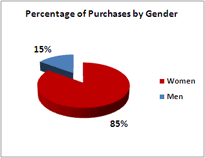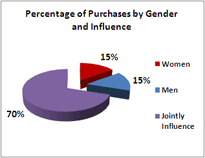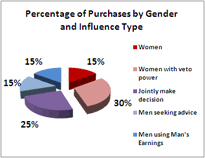First, it was The End of Men, the controversial essay in The Atlantic by Hanna Rosin, who argued that current social trends don’t bode well for the survival of men in the modern economy. While a little breathless in her assessment, Ms. Rosin came to some valid conclusions that should at least raise awareness that we’re in the midst of a societal shift. Yes, women are getting bachelor’s degrees and master’s degrees at a rate of three-to-two of men. Yes, women make up the majority of the workforce for the first time in U.S. history. Yes, women are more economically empowered than ever. I previously wrote my take on her essay here and here and, frankly, got too caught up in the hysteria myself.
Seven months later, Kay S. Hymowitz, senior fellow at the conservative Manhattan Institute, writes an article for the Saturday (2/19/11) Wall Street Journal entitled Where Have the Good Men Gone?, promoting her book Manning Up: How the Rise of Women Has Turned Men Into Boys.
If you don’t mind, I’d like to call out some of the terms and statements used throughout the article:
“Semi-hormonal adolescence” … “they might as well just have another beer” … “pre-adulthood” … “spend their days playing video games” … “beer pong” … “puerile shallowness” … “pig heaven” … “[for women] husbands and fathers are now optional” … “[men] treat women like disposable estrogen toys” … “array of media devoted to his every pleasure” … “men’s attachment to the sandbox” … “most men in their 20s hang out in a novel sort of limbo, … state of semi-hormonal adolescence”
We’re hedonistic, beer-swilling, women-abusing, entertainment-focused slobs. Hymowitz says in another article, “…who needs commitment when there is a fantasy football team league to dominate, the possibility that a gaming product better than the Xbox 360 could be on the horizon, and your live-in girlfriend will have sex with you whenever you want?” Amen, sister!
It’s Really About Generation Y
I don’t think it’s coincidence that the freak-out about 20-something men is happening around the same time that HR managers, sociologists, psychologists and marketers are feverishly trying to understand Gen Y. Our generation has been poked and prodded for years as Boomer parents simultaneously attempt to make up for the sins of their parents’ generation while doing penance for their own youthful indiscretions (roughly translated to “my parents didn’t love me and I don’t want you to do drugs like I did”). This shift in parental focus — from authority to friend (evidenced by sites like When Parents Text) — has produced a generation that seems to be doing things differently. (Note: for a more balanced take on Gen Y, I suggest Gen Y Now: How Generation Y Changes Your Workplace and Why It Requires a New Leadership Style by Buddy Hobart, a seasoned former-Gen-Y-hater CEO of the consulting firm Solutions 21 and Herb Sendek, head men’s basketball coach at Arizona State University, who knows a little bit about leading Gen Y).
There is an exhaustive amount of information, data and commentary that justifies about every belief about our generation. On one side, Millenials are an aimless generation of slackers and misfits who feel entitled to high salaries and plenty of leisure time, but are so focused on their smart phones that they’re incapable of even the most basic of human interactions. On the other side, Gen Yers are a superhuman contingent of tech-savvy team players who are leveraging the extensive opportunities afforded them by families they love, to broaden their horizons, befriend people of various races and sexual orientations, and help to bring the dawn of the Age of Aquarius. Just Google Gen Y. You’ll find it all.
Despite plenty of data that could support her opinion, Hymowitz writes an article that is nearly devoid actual numbers. Sure, she mentions educational attainment statistics and unemployment rates for men and women in their 20s, along with a graph showing the average age at which couples marry in both the U.S. and other developed countries (Ack! We might be like France!). These three data points might suggest that men are doomed. The data can also be explained from a different perspective — men are focusing on good, well-paying jobs that don’t require four-year degrees (e.g. plumbers, welders, mechanics, careers in the energy industry), unemployment always hits men harder than women (construction and other labor-related jobs are the first to go in a recession), and the age at which people get married has been trending upward for years as people attempt to be more responsible by working to get on sound financial and career footing before having and raising children.
Furthermore, many of her arguments are gender-neutral. Take the following:
[20-something men and women] are looking not just for jobs but for “careers,” work in which they can exercise their talents and express their deepest passions … For today’s pre-adults, “what you do” is almost synonymous with “who you are,” and starting a family is seldom part of the picture.
In short, it’s intellectually dishonest to blame (credit?) an entire set of societal and economic trends on 20-something men. It’s also incredibly easy to find arguments that support either side. Can we just admit that it’s damn hard to pin down a group of people that makes up roughly 25% of the U.S. population?
Men-As-Adult-Juveniles — 160 Years in the Making
Ever heard of Dr. Dan Kiley? He wrote a book implicating the man-child in The Peter Pan Syndrome: Men Who Have Never Grown Up. The quick summary: “[the book] discusses the problem of men who, although they have reached adulthood, are unable to cope with feelings and responsibilities, identifying the symptoms of the syndrome and offering guidelines on coping with and treating the problem.” Sounds awfully familiar. It was written in 1983.
Even Hymowitz turns back the clock. “American men have been struggling with finding an acceptable adult identity since at least the mid-19th century”, she states, apparently believing that men had the time to contemplate their identities while avoiding the fate of the 610,000 people who died in the Civil War. A century later, “the arrival of Playboy in the 1950s seemed like the ultimate protest against male domestication; think of the refusal implied by the magazine’s title alone,” suggesting that it was only in the mid-20th century that men enjoyed looking at beautiful naked women. I’m just disappointed that she forgot to mention the roaring 20s and the baby boom (those were the days of male class and chastity; when marital rape wasn’t considered rape at all). At least those men were married!
But now it’s 2011, and her citations of male-oriented pop culture are as gratuitous as the T&A featured in Maxim. She complains, “their male peers often come across as aging frat boys, maladroit geeks or grubby slackers—a gender gap neatly crystallized by the director Judd Apatow in his hit 2007 movie ‘Knocked Up.’ [Note: Hymowitz goes on to mischaracterize the female lead as a totally independent up-and-comer when she actually lives in her sister’s pool house and is none-too-eager to leave]” She mentions “overgrown boy actors” (Steve Carell, Luke and Owen Wilson, Jim Carrey, Adam Sandler, Will Farrell and Seth Rogen), Spike TV, crotch shots, awesome car crashes, Star Wars and beer pong competitions. Frankly, I’m disappointed that she did not mention Axe, the men’s line of personal care products that is promoted in a way that objectifies women. The one argument I could get behind, she fails to mention.
My frustration with this argument is that the same can be said for 20-something women. Are shows like The Bachelor, Keeping Up With the Kardashians, and the various Real Housewives somehow more virtuous? Aren’t some women guilty of coming across as mean, shopping-obsessed, man-hating girly-girls who are so focused on their own wants and needs that their narcissism renders them incapable of recognizing others’ feelings? Is Cosmopolitan magazine any less trashy? Are actresses and entertainers like Paris Hilton, Katy Perry, Brittney Spears, Lindsay Lohan, Christina Aguilera and Kim Kardashian exhibiting behaviors of a “good woman”? What about the obsession many women have for the Twilight series? Sex toy parties and pole dancing exercise classes? Lifetime? For every movie like Hangover, there’s Sex and the City 2.
To convict men for enjoying mindless entertainment is preposterous. It is dishonest to condemn guilty pleasures targeted to men while ignoring those of women. Finally, to believe that men and women go on to emulate these gender extremes is a cynical, out-of-touch, and unrealistic view unbecoming of a leading scholar.
Some of This is Great News for Women
One of the major goals of feminism was to provide women equal opportunity in the working world. While there is plenty of work to do (CEOs are overwhelmingly male, women earn roughly 77% of men), some of the trends Hymowitz uses to argue the demise of men are actually great news for women’s equality. For instance:
“In a number of cities, [20-something women] are even out-earning their brothers and boyfriends.”
Wait, you mean that some women are holding the financial position that men have held for damn near forever? How is this happening? Women are getting their MBAs, going to law school and becoming doctors (not to mention that the teaching profession, which is still dominated by women, is forcing many to get their Master’s degrees). Why are women showing more confidence in the classroom? They’re no longer being taught that they’re educational second-class citizens.
It is beyond my comprehension that two generations of hard work that leveled the playing field for women is beginning to bear fruit and the resulting reaction is one of derision rather than celebration. The world is not a zero-sum game. It is genuinely a better place when you combine the skills and strengths of men and women, which might be why Gen Y prefers teamwork. Perhaps I’m missing the canary in the coal mine, but I’m not all that concerned that women might finally have a shot at earning the top spots in organizations devoid of women just a generation ago.
The Family is Changing
One of the reasons that women have entered the workforce en masse is that raising a family is expensive and almost requires two incomes. With greater pressure on children to be successful and well-rounded, parents must pay for piano lessons, soccer leagues, after-school tutoring and educational summer camps. This stuff isn’t cheap (ever try buying hockey equipment?). Besides, it’s thought nearly child abuse not to take your children on vacation every year.
Seeing this pressure, many Gen Y men (and women) are trying to build their careers in order to contribute their fair share to a two-income household. In addition, 20-something men are recognizing and accepting that their wives might out-earn them. The concept of a 50-50 relationship is becoming more prevalent and gender roles are changing. There are more stay-at-home dads and other non-traditional family structures. These shifts are a function of new economic circumstances and much larger social trends.
Family is also beginning to reach beyond heterosexual couples as gays and lesbians are finding new opportunities to legally establish their relationships in a handful of states and Washington D.C. The federal government under the Obama administration has directed the Department of Justice to stop enforcing the Defense of Marriage Act (the law defining marriage as one man and one woman). Regardless of the lawsuits currently working their way through the courts, most notably the Bush v. Gore lawyers who have teamed up to assure the recognition same-sex marriages at the federal level, generational attitudes toward gays and lesbians show a march to equality inevitability. In the midst of this social change, these committed couples are adopting and raising children, which will likely grow as the legal impediments to gay marriage are broken down.
Yes, there are too many single parents (34% of children are in single-parent households). Too many children suffer through their parents’ divorce. Non-traditional families are even more prevalent. We don’t know how these situations will impact our future society, but I feel confident saying that whatever happens, good or bad, it won’t be the result of the Xbox 360, beer pong or fantasy football.
Where She Deserves Some Credit
This quote might be as clear as anything she says, if only she omitted “undomesticated”:
“Today’s pre-adult male is like an actor in a drama in which he only knows what he shouldn’t say. He has to compete in a fierce job market, but he can’t act too bossy or self-confident. He should be sensitive but not paternalistic, smart but not cocky. To deepen his predicament, because he is single, his advisers and confidants are generally undomesticated guys just like him.”
She’s absolutely right! The country is in a challenging economic environment. Gen Yers are just hoping to find jobs in an era where Baby Boomers are staying in jobs longer, which has slowed the workforce turnover by a decade-plus. Men aren’t sure whether opening a door for a woman will get him a “thank you” or “I’m capable of doing it myself thank-you-very-much”. Who pays for the first date? How do men know when to accept an offer to split the check or turn it down? How do men balance “being a good man” and being thought of as a misogynist for what was once considered chivalry? And those advisers and confidants — they’re a peer support group of guys and women. Sometimes, our age-mates are not the perspective we need. In those cases, we ask our parents, our grandparents, our aunts, uncles, bosses, older friends and mentors — not exactly a sign of oblivious immaturity.
She addresses another issue that’s tough for men to navigate — the lack of milestones of adulthood:
“But pre-adults differ in one major respect from adolescents. They write their own biographies, and they do it from scratch. … I see it as an expression of our cultural uncertainty about the social role of men. It’s been an almost universal rule of civilization that girls became women simply by reaching physical maturity, but boys had to pass a test. They needed to demonstrate courage, physical prowess or mastery of the necessary skills. The goal was to prove their competence as protectors and providers. Today, however, with women moving ahead in our advanced economy, husbands and fathers are now optional, and the qualities of character men once needed to play their roles—fortitude, stoicism, courage, fidelity—are obsolete, even a little embarrassing.”
This is a difficulty for us — it is hard to write our own script and we’re challenged by what to write. Conventional wisdom that the world is a zero-sum game and the rise of women necessarily means the fall of men, we’re being given mixed messages and becoming more defensive of “our turf” (watch a family comedy, like Everybody Loves Raymond, and you’ll see the in-control wife having to suffer a witless husband). Add the pressures we face to be quickly successful in an economy that isn’t lending itself to success and it becomes overwhelming. We’re trying to be all the things we’ve been taught that the modern man can be — as Hymowitz says, “sensitive but not paternalistic, smart but not cocky”.
Men are confused. Men are being told their interests are stupid (see this commercial from McDonald’s). Men are told they’re supposed to be sensitive. But, don’t be overly-sensitive because they need to be strong. But don’t be overly strong because women need to be in charge, too. But don’t let women be too in charge or you’ll be an unattractive pushover. But be ready to give in and compromise because a relationship should be 50-50. And for the love of God, dress stylishly, but not too stylishly because you’ll be thought of as gay. Men are told to accept women for their interests no matter how banal (I MUST watch Teen Mom tonight), yet are castigated for watching football on Sundays. When we point these things out, many of our female companions respond, “I don’t know why you’d want to date us!”
Maybe There’s a Different Conclusion to be Made
Here’s the thing … the kids are alright. Really. We are. We got this.
Social shifts have never been clean. Whether it’s directing fire hoses at civil rights activists in the 60s, figuring out how smoking pot and listening to Stairway to Heaven brings the end to war and racial injustice in the 70s, coming to terms with AIDS and economic downfall in the 80s, attempting to make sense of why we all exist in the 90s, or sorting through the emotional turmoil of war and terror in the aughts, generations of young American men and women have proven themselves to be capable of demonstrating the kind ingenuity, discretion, and know-how required to lead this in this world as adults. Facebook, Twitter, Skype and other internet tools are turning freedom movements in the Middle East that are 30 years in the making into successes as a result of the leadership of young people using technology developed by 20-something counterparts.
I cannot and will not apologize for the loser men with whom the comedian Julie Klausner has slept (she’s quoted early in the Hymowitz article). Everyone knows a parent’s-basement-dwelling unemployment-collecting slacker 20-something who has permanently created an indentation of his considerable butt in a 70s-era couch as a result of hours-long video game binges. Every guy I know has a friend who treats women as sex objects, looking to rack up points like the video games Hymowitz likes to cite. There’s the Star-Wars-friend and the guy-who-drinks-too-much friend and the sports-obsessed-did-you-see-that-play-on-SportsCenter friend. We choose these friends because, in most cases, they represent a part of ourselves through whom we live vicariously. We’re as likely to pound beers as in the movie Beer Fest as women are likely to have sex with anything that moves a la Samantha in Sex and the City. It’s stupid, mindless entertainment that allows us to imagine a life that, for just a moment, appeals to our lesser reptilian selves. Despite Hymowitz’ belief that “most [emphasis mine] men in their 20s hang out in a novel sort … semi-hormonal adolescence”, it is simply untrue. Most men in their 20s are simply navigating the world like everyone else, including our female counterparts.
Realizing that there are generational gaps in thinking, I’d like to propose some questions. For those who complain about how “these kids got trophies for everything”, I’d like to ask, who bought the trophies? [Hint: Boomer parents] Who doesn’t want a higher salary, especially when the minimum requirement for a job includes a graduate degree and well-rounded background by the age of 24? Does anyone turn down more vacation time? How many people who married in their early 20s wish that they had thought about it a little more as they sign their divorce papers in their 40s? Would most couples want to financially struggle in the beginning of their marriage as they’re trying to have and raise children? Who would bypass traveling and other once-in-a-lifetime experiences at a time in their lives when there are few consequences? As life expectancy extends into the 80s and beyond, is it horrible that 20-somethings take more time to figure out what makes sense to them? Who wouldn’t want to work to find the ideal job and life? Could previous generations be irritated/jealous that Gen Y has the guts to pursue these goals? As I’ve heard several HR consultants say, “Generation Y asks for what we all secretly want.”
A Modest Proposal
Here’s the disclaimer … I love beer. I can sink a ping pong ball in a cup like champ (there’s nothing like the pressure of double redemption). I own a Wii and have rocked out on Guitar Hero. I have a subscription to Esquire. I own Superbad, The Hangover, Billy Madison and thoroughly enjoyed Hot Tub Time Machine. I’m dating a medical student who will likely out-earn me sometime in the future. Some of my friends are gay, white, black, Asian, Hispanic, Indian, Pakistani, poor, rich, slackers, over-achievers, aged 14 to 88, married with children, and/or perpetually single. I took advantage of opportunities in my 20s: I failed at a couple of jobs, traveled to Eurpoe, missed my rent because my graphic design freelance work wasn’t paying the bills, and survived on wings and beer for the better part of my 25th year. Shockingly, I survived. I’m gainfully employed making a decent salary in a good job, pursuing my MBA, own a few successful companies (including one focused on beer), have a great family life, and am not terrified by the thought of marriage. Ms. Hymowitz, I’m both your pathetic typecast and the person who is the exception to your rule.
Since you’re comfortable with dispensing unsolicited advice, I’d like to offer you some myself. Get out of Manhattan and come to Pittsburgh. Have a few beers at a bar with my friends. Take in a game of hockey with us (seriously, you have to appreciate the talent of Sidney Crosby). Ask us questions. Talk to us about our love lives. Ask us about our hobbies (from golf to home brewing to skydiving). Maybe you’ll realize that we’re stressed out and have our own ways of blowing off steam. Maybe you’ll realize that we adore our girlfriends who are feeling equal pressure to succeed in their own complicated lives. Maybe you’ll realize that our parents, grandparents, aunts and uncles are our best friends and teachers. Maybe you’ll appreciate that even the most slacker of us are volunteers and go to church on Sunday. Maybe you’ll enjoy hanging out with us and want to do it again or, in male parlance, come to the dark side of the force.










